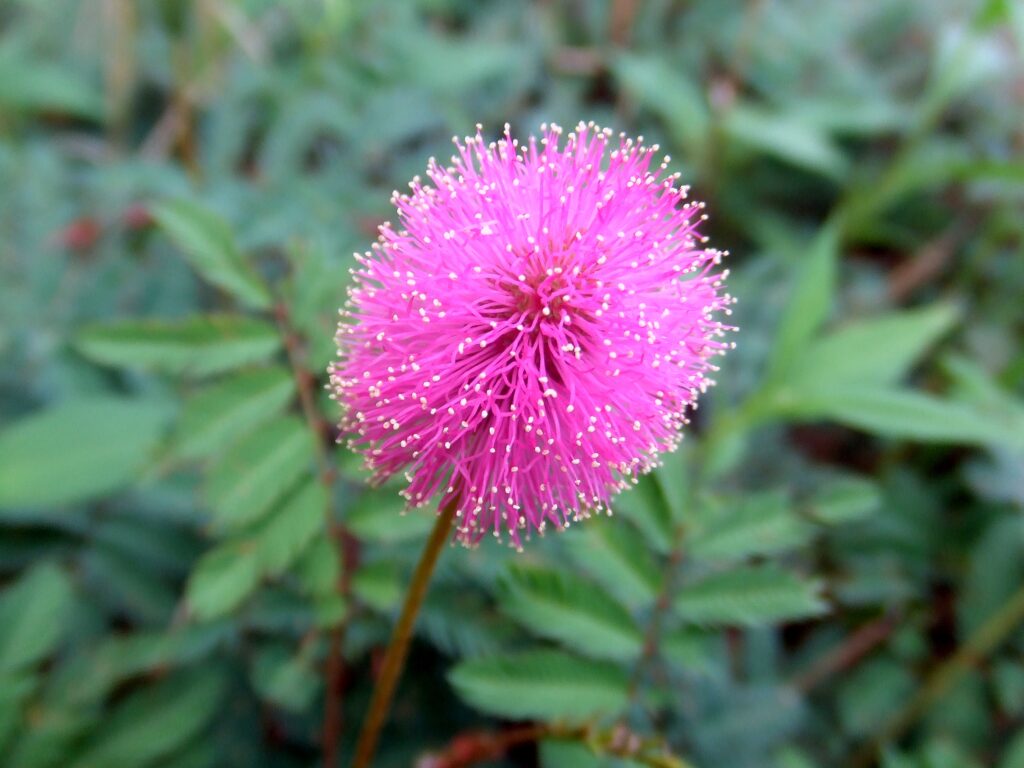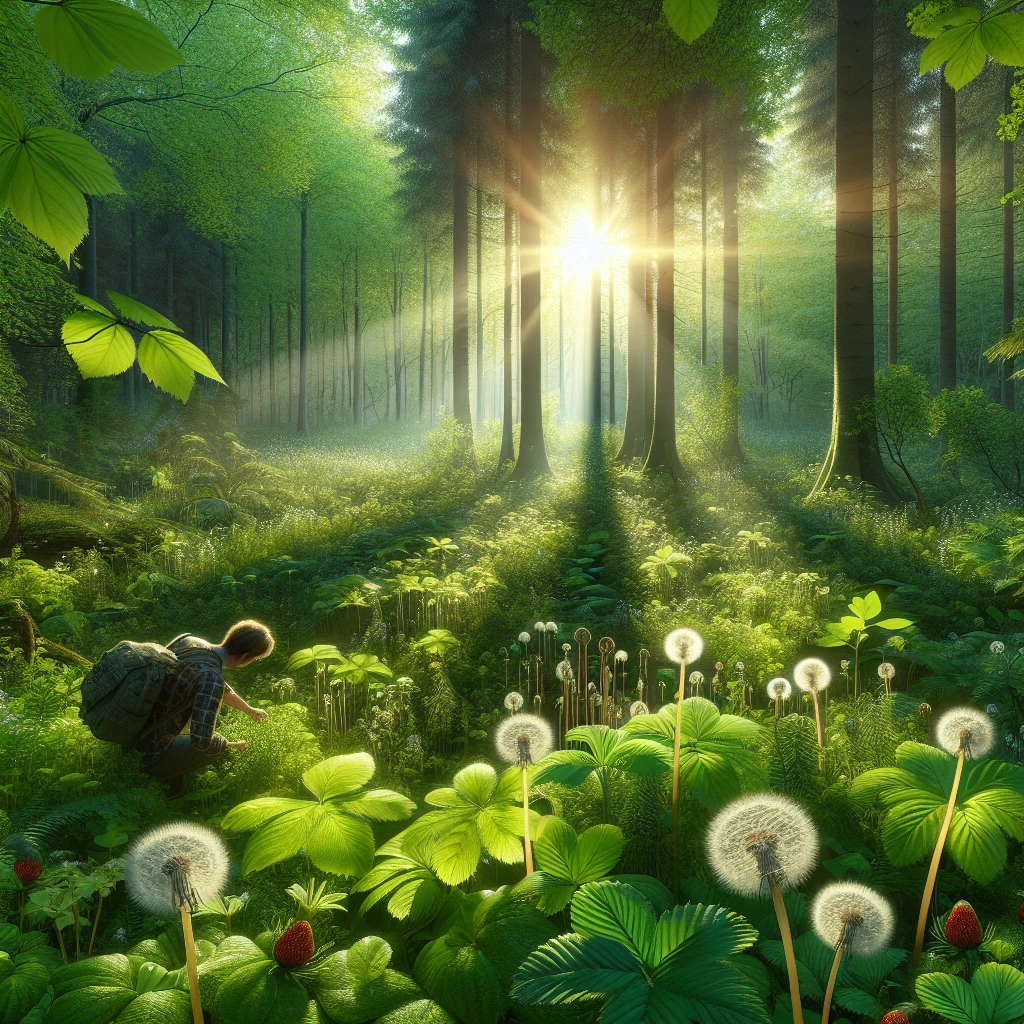

Edible wild plants are plants that can be safely consumed by humans and are found growing in nature. They are important for survival in the wild and can provide essential nutrients when other food sources are not available.
Foraging for edible wild plants is a valuable skill that can help individuals connect with nature and learn valuable survival techniques.
Foraging for edible wild plants can provide a sustainable and environmentally friendly food source. These plants are often rich in minerals, vitamins, and antioxidants, making them a healthy addition to the diet.
However, it is important to be cautious and properly identify these plants, as consuming the wrong ones can lead to severe illness or even death. With the proper knowledge and guidance, foraging for edible wild plants can be a rewarding and enriching experience.
Check out this Youtube video: “10 Wild Edible Greens to Harvest- Foraging Plants – YouTube” to learn essential foraging and cooking skills for survival and emergency preparedness.
History of Edible Wild Plants
Historical significance of foraging for wild plants
Foraging for wild plants holds immense historical significance as it was a vital means of sustenance for our ancestors and played a central role in shaping their cultures and ways of life. Alongside hunting, foraging was one of the primary methods of food production, fostering an intimate connection with the natural environment and providing essential nourishment.
Traditional uses of edible wild plants
The traditional uses of edible wild plants are deeply rooted in human history, with these plants serving as essential components of the diet for hunter-gatherer and forager cultures in the past. Even today, these plants continue to play a pivotal role in various agricultural systems, offering not only sustenance but also contributing to medicine, fodder, fuel, construction, and other diverse applications.
| Wild Edible Plant | Traditional Use |
|---|---|
| Artemisia scoparia | Seeds, flowers, leaves, aromatic properties |
| Carum carvi | Fruits, seeds, aromatic properties |
| Mieso | Nutrition, fodder, fuel, medicine |
| Tribal Areas | Source of nutrition and cultural practices |
Foraging for wild plants and the traditional uses of edible wild plants are rich in historical significance, showcasing the deep-rooted connection between humans and the natural world, and the invaluable role these plants have played in sustaining and shaping human life throughout history.
Safety Guidelines for Foraging
All right, let’s talk about the importance of proper identification when it comes to foraging for wild plants. It’s absolutely crucial to be 100% certain about the identity of the plants you are planning to forage.
One small mistake can lead to serious consequences, so take the time to thoroughly understand and identify each plant before considering it for consumption. Always remember, when in doubt, do not consume!
Importance of proper identification
Proper identification of wild plants is essential to avoid any mishaps. One way to ensure accurate identification is to pay close attention to the plant’s reproductive parts such as cones, seeds, fruits, and flowers.
Additionally, examining the stalk, spotting distinguishing traits, and noting the overall height and shape of the plant can provide valuable clues. It’s always better to be safe than sorry when it comes to identifying wild plants for foraging.
Risks of misidentification
The risks of misidentification between edible and poisonous plants can have severe consequences. Cases of poisoning due to plant ingestion are increasingly being reported, emphasizing the need for caution and thorough identification.
The emergence of look-alike plants further complicates the matter, making it crucial to exercise extreme care and diligence when foraging for wild plants.
Tips for safe foraging
When it comes to safe foraging, there are a few essential tips to keep in mind. Always be certain of the identity of the plants you are foraging, and never consume anything without being absolutely sure of its identification.
Additionally, washing your harvest thoroughly, regardless of its source, is a simple yet effective practice to ensure safety. It’s all about being cautious, respecting beneficial harvesting methods, and following the law when foraging for edible wild plants.
Nutritional Benefits of Edible Wild Plants
When comparing the nutritional value of wild plants to cultivated ones, wild edibles tend to contain more beneficial nutrients like vitamins and minerals on a per-weight basis than cultivated foods. According to various sources, wild plants generally have greater amounts of vitamins, minerals, and other nutrients compared to cultivated foods.
This can be attributed to their natural and unaltered state, which preserves their nutrient density.
Health benefits of consuming wild plants
The consumption of wild plants offers numerous health benefits, primarily due to their rich content of antioxidants and phytochemicals, which act as protective measures for both the plants and individuals when consumed. Additionally, wild plant greens serve as excellent sources of vitamin C, promoting healthy gums, teeth, and skin.
Notably, young, raw Fireweed leaves provide higher levels of vitamin C and vitamin A compared to more mature plants.
Popular Edible Wild Plants
Blueberries
Wild blueberries are small shrubs, about 8-40 inches tall, with a distinct five-pointed calyx. They are rich in antioxidants and grow in eastern Canada and the eastern and southern United States.
Blueberries are versatile and can be eaten fresh, used in baking, or made into jams and jellies.
Dandelions
Dandelions, often seen as weeds, are packed with vitamins A, B, C, and D, along with minerals like iron and potassium. The leaves can be added to salads, sandwiches, and teas, while the roots can be used to make dandelion root coffee.
They offer numerous health benefits, such as reducing cholesterol and regulating blood sugar.
Morels
Found in wooded areas throughout North America and Europe, morels are prized for their nutty and earthy flavor. They are best used in cooking and are a delicacy in many cuisines.
Due to their unique texture and taste, morels are highly sought after by food enthusiasts and chefs.
Wild Leeks
Wild leeks, also known as ramps, are wild onions with a strong garlic-like flavor. They are commonly used in soups, stews, and omelets.
Wild leeks are foraged in the spring and are revered for their culinary value, adding a distinct and pungent taste to dishes.
| Plant | Location | Culinary Use |
|---|---|---|
| Blueberries | North America | Fresh, Baking, Jams |
| Dandelions | Worldwide | Salads, Teas, Coffee |
| Morels | North America, Europe | Cooking, Delicacy |
| Wild Leeks | Eastern North America | Soups, Stews, Omelets |
Enjoy the bounty of nature as you explore and indulge in these delightful, wild-grown culinary treasures.
Foraging Tips and Techniques
Identifying the best places to forage
To identify the best places to forage for edible wild plants, look for diverse ecosystems with a variety of vegetation, such as forests, meadows, and riverbanks. These areas often offer a rich abundance of edible plants, including wild berries, mushrooms, and greens.
Additionally, consider areas with minimal pollution and pesticides for safe foraging.
Tools and equipment for foraging
When preparing for foraging, essential tools and equipment include field guides for plant identification, protective gloves, a reliable pruning knife or shears for harvesting, a shovel for digging up roots, and collection containers for carrying your harvest. These tools aid in safely and effectively gathering a variety of edible wild plants.
Best practices for sustainable foraging
Adopt sustainable foraging practices by avoiding over-harvesting and only gathering what is necessary. It’s crucial to refrain from harming the ecosystem and wildlife by respecting natural habitats and not disturbing the balance of the environment.
Additionally, prioritize foraging invasive species to contribute to ecological balance while being respectful of other foragers and leaving the foraging areas cleaner than when you arrived.
Cooking with Edible Wild Plants
Recipes and cooking methods
I have a favorite method for cooking most wild greens: Wash and chop, then sauté in olive oil or bacon fat with salt, garlic, chile, and a touch of broth or wine for added flavor.
Substituting wild plants in recipes
When it comes to substituting wild plants in recipes, consider using myrtle or Umbellularia as alternatives for bay leaves. Additionally, you can explore using meadowsweet, sweetfern, wild onions, ramps, and other aromatic herbs as substitutes for traditional spices.
Flavor profiles of various wild plants
Dandelions are versatile and can be used in various dishes, while asparagus offers a unique and earthy flavor to recipes. Nettles provide a slightly spinach-like taste, and garlic mustard adds a peppery kick to meals.
Elderberries bring a sweet and tart flavor that works well in desserts or beverages.
| Wild Plant | Flavor Profile |
|---|---|
| Dandelion | Versatile and slightly bitter |
| Asparagus | Earthy and distinct |
| Nettle | Spinach-like with a hint of earthiness |
| Garlic Mustard | Peppery and bold |
| Elderberry | Sweet, tart, and versatile |
Environmental Impact of Foraging
Sustainability and ethical foraging practices
Sustainability and ethical foraging practices are crucial for minimizing the environmental impact of foraging. Foragers should follow a strict code of conduct, ensuring that their harvesting methods do not harm the natural habitats of the plants and wildlife. By adhering to sustainable foraging practices, individuals can help maintain the ecological balance while also preserving the longevity of edible wild plants for future generations.
Impact on local ecosystems
Foraging activities can significantly impact local ecosystems when not carried out responsibly. Careless harvesting techniques and overconsumption of wild plants can lead to ecological imbalances, causing damage to vegetation and disturbing the natural habitat of wildlife.
It is essential for foragers to be mindful of their impact and prioritize the restoration and conservation of the ecosystems they engage with.
| Positive Impacts | Negative Impacts |
|---|---|
| Contributes to biodiversity conservation | Disruption of natural habitats |
| Minimizes transportation emissions | Overharvesting of plant species |
| Promotes sustainable use of natural resources | Disturbance to wildlife populations |
| Supports local food systems | Potential damage to vegetation |
The table above highlights both the positive and negative impacts of foraging on local ecosystems, emphasizing the importance of responsible foraging practices.
Remember, environmental sustainability starts with individual actions, and by adopting ethical and sustainable foraging practices, we can minimize the detrimental effects on our natural surroundings.
Common Misconceptions About Edible Wild Plants
Hey folks, let’s debunk some myths about toxicity associated with edible wild plants. While mushrooms seem to steal the spotlight, the truth is, there are more poisonous plants than mushrooms in the wild.
So, don’t let the fear of toxicity hold you back from exploring the world of edible wild plants.
As for addressing concerns about foraging, it’s crucial to note that some toxic plants can resemble edible ones, leading to confusion, especially in the wild and even in vegetable gardens. However, with proper knowledge and guidance, foraging for wild edibles can be done safely, ensuring a delightful and risk-free experience.
So, remember to educate yourself, be cautious, and enjoy the abundance of nature’s offerings while foraging for edible wild plants!
Health and Wellness Benefits of Foraging
Mental health benefits of foraging
Foraging for edible wild plants provides a sense of purpose and accomplishment, contributing to improved mental well-being. The act of searching for and harvesting wild food fosters a deeper connection to nature, reducing stress, anxiety, and depression.
This process of mindful engagement with the environment enhances mental clarity and cultivates a sense of mindfulness, promoting overall emotional balance.
Connection to nature and the environment
Engaging in foraging encourages a profound connection with the natural environment. It instills a heightened appreciation for the Earth’s resources and the interdependence of all living organisms.
Furthermore, foraging offers an opportunity to witness firsthand the delicate balance of ecosystems, fostering a sense of stewardship for the environment. Through responsible foraging practices, individuals can become more attuned to sustainable resource management, ultimately contributing to environmental preservation and biodiversity conservation.
Legal Considerations for Foraging
Laws and regulations regarding foraging
In Ontario, foraging laws and regulations are in place to protect natural habitats and ensure sustainable harvesting. It’s essential to familiarize oneself with the specific rules governing foraging activities, such as the prohibition of uprooting plants and the limitations on the quantity that can be harvested.
Violating these regulations can lead to fines and legal repercussions.
Permits and permissions for foraging in different areas
When foraging in Ontario, it’s crucial to obtain permission from landowners before harvesting on private property. This usually requires written consent to avoid any conflicts or legal issues.
However, harvesting edible wild plants from public, Crown land is permitted within certain guidelines. Additionally, individuals or businesses may need environmental permissions from the Ministry of the Environment, Conservation and Parks for specific foraging activities.
Recommended Amazon Products for Foraging Edible Wild Plants
Here’s a curated list of products that can help you forage for edible wild plants with ease. These recommendations are based on functionality, price, and reviews.
The Forager’s Harvest: A Guide to Identifying, Harvesting, and Preparing Edible Wild Plants


This comprehensive guide provides detailed information on a wide variety of edible wild plants. The author offers expert tips on identification, harvesting, and preparation, making it an essential resource for foragers.
| Pros | Cons |
|---|---|
| Detailed content | Slightly pricey |
| High-quality images | Large volume |
| Expert guidance |
Morakniv Craftline Robust Trade Knife


This high-quality knife is durable and well-suited for cutting and harvesting wild plants. Its ergonomic handle and strong blade make it a reliable tool for foraging expeditions.
| Pros | Cons |
|---|---|
| Durable | May require sharpening |
| Ergonomic handle | |
| Reliable cutting |
VIVOSUN Gardening Gloves


These gloves provide protection while foraging, featuring grippy rubber palms for a secure hold on plants and a breathable design for all-day comfort.
| Pros | Cons |
|---|---|
| Protection | Sizing may run small |
| Grip | |
| Comfortable |
Columbia Men’s Silver Ridge Convertible Pants


These convertible pants are ideal for outdoor foraging, with a lightweight and breathable design. The built-in UPF 50 sun protection adds an extra layer of safety.
| Pros | Cons |
|---|---|
| Lightweight | Sizing may not be accurate |
| Versatile | |
| Sun protection |
The Complete Guide to Edible Wild Plants


This comprehensive guide provides detailed information on a wide variety of edible wild plants. The author offers expert tips on identification, harvesting, and preparation, making it an essential resource for foragers.
| Pros | Cons |
|---|---|
| Detailed content | Slightly pricey |
| High-quality images | Large volume |
| Expert guidance |
Top Recommended Product for Foraging Edible Wild Plants
If you’re looking for the best solution for foraging edible wild plants, we highly recommend The Forager’s Harvest. This comprehensive guide provides detailed information on a wide variety of edible wild plants and offers expert tips on identification, harvesting, and preparation, making it an essential resource for foragers.


Ready to improve your foraging skills? Check out The Forager’s Harvest today for the best results!


Conclusion
It is important to understand the various types of edible wild plants that can be found in different regions. These plants can provide a valuable source of nutrition and sustenance, especially in survival situations.
However, it is crucial to be well-informed and educated about the identification and preparation of these plants to avoid any potential risks to health.
Furthermore, incorporating edible wild plants into one’s diet can offer a diverse range of flavors and nutrients that may not be readily available in cultivated foods. By responsibly foraging for and incorporating these plants into meals, individuals can expand their culinary repertoire and embrace a more sustainable and environmentally-friendly approach to food consumption.
While the consumption of edible wild plants can offer numerous benefits, it is essential to exercise caution and prudence when sourcing and preparing these plants. By following proper guidelines and seeking guidance from experienced foragers, individuals can safely and responsibly enjoy the benefits of incorporating edible wild plants into their diet.









